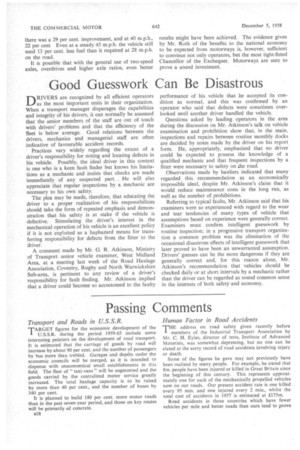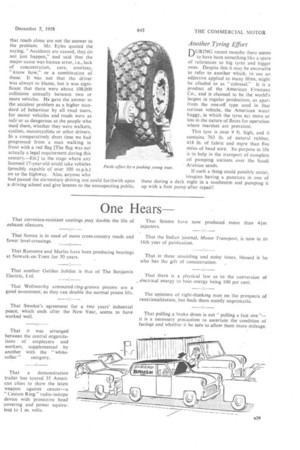Passing Comments
Page 34

Page 35

If you've noticed an error in this article please click here to report it so we can fix it.
Transport and Roads in U.S.S.R.
TARGET figures for the economic development of the U.S.S.R. during the period 1959-65 include some interesting pointers on the development of road transport. It is estimated that the carriage of goods by road will increase by about 90 per cent. and the number of passengers by bus more than trebled. Garages and depots under the economic councils will be merged, as it is intended to dispense with uneconomical small establishments in this field. The fleet of " taxi-vans " will be augmented and the goods carried by the centralized motor service greatly increased. The total haulage capacity is to be raised by more than 40 per cent., and the number of buses by 340 per cent.
It is planned to build 180 per cent, more motor roads than in the past seven-year period, and those on key routes will be primarily of concrete.
s28
Human Factor in Road Accidents
THE address on road safety given recently before members of the Industrial Transport Association by Mr. C. H. Eyles, director of tests, Institute of Advanced Motorists, was somewhat depressing, but no one can be elated at the sorry record of road accidents involving injury or death.
Some of the figures he gave may not previously have been realized by many people. For example, he stated that 8m. people have been injured or killed in Great Britain since the beginning of this century. This represents approximately one for each of the mechanically propelled vehicles now on our roads. Our present accident rate is one killed every 95 min. and one injured every 2 min., whilst the total cost of accidents in 1957 is estimated at £175m.
Road accidents in those countries which have fewer vehicles per mile and better roads than ours tend to prove that roads alone are not the answer to the problem. Mr. Eyles quoted the saying, "Accidents are caused, they do not just happen," and said that the major cause was human error, i.e., lack of concentration, care, courtesy, "know how," or a combination of these. It was not that the driver was always to blame, but it was significant that there were about 108,000 collisions annually between two or more vehicles. He gave the answer to the accident problem as a higher standard of behaviour by all road users, for motor vehicles and roads were as safe or as dangerous as the people who used them, whether they were walkers, cyclists, motorcyclists or other drivers. In a comparatively short time we had progressed from a man walking in front with a red flag [The flag was not actually a legal requirement during this century.---End to the stage where any licensed 17-year-old could take vehicles (possibly capable of over 100 m.p.h.) on to the highway. Also, anyone who had passed the elementary driving test could forthwith open a driving school and give lessons to the unsuspecting public.
Another Tyring Effort
DURING recent months there seems
to have been something like a spate of references to big tyres and bigger ones. Despite this it may be excusable to refer to another which, to use an adjective applied to many films, might be alluded to as "colossal." It is a product of the American Firestone Co., and is claimed to be the world's largest in regular production, as apart from the one-off type used in that curious vehicle, the American water buggy, in which the tyres act more or less in the nature of floats for operation where marshes are prevalent.
This tyre is over 9 ft. high, and it contains 763 lb. of natural rubber, 418 lb. of fabric and more than five miles of bead wire. Its purpose in life is to help in the transport of complete oil pumping stations over the Saudi Arabian sands.
If such a thing could possibly occur, imagine having a puncture in one of these during a dark night in a sandstorm and pumping it up with a foot pump after repair!
























































































































